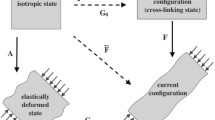Abstract:
We study the monodomain (single-crystal) nematic elastomer materials, all side-chain siloxane polymers with the same mesogenic groups and crosslinking density, but differing in the type of crosslinking. Increasing the proportion of long di-functional segments of main-chain nematic polymer, acting as network crosslinking, results in dramatic changes in the uniaxial equilibrium thermal expansion on cooling from the isotropic phase. At higher concentration of main chains their behaviour dominates the elastomer properties. At low concentration of main-chain material, we detect two distinct transitions at different temperatures, one attributed to the main-chain, the other to the side-chain component. The effective uniaxial anisotropy of nematic rubber, r(T) = / proportional to the effective nematic order parameter Q(T), is given by an average of the two components and thus reflects the two-transition nature of thermal expansion. The experimental data is compared with the theoretical model of ideal nematic elastomers; applications in high-amplitude thermal actuators are discussed in the end.
Similar content being viewed by others
Author information
Authors and Affiliations
Additional information
Received 25 June 2001 and Received in final form 29 September 2001
Rights and permissions
About this article
Cite this article
Tajbakhsh, A., Terentjev, E. Spontaneous thermal expansion of nematic elastomers. Eur. Phys. J. E 6, 181–188 (2001). https://doi.org/10.1007/s101890170020
Issue Date:
DOI: https://doi.org/10.1007/s101890170020




